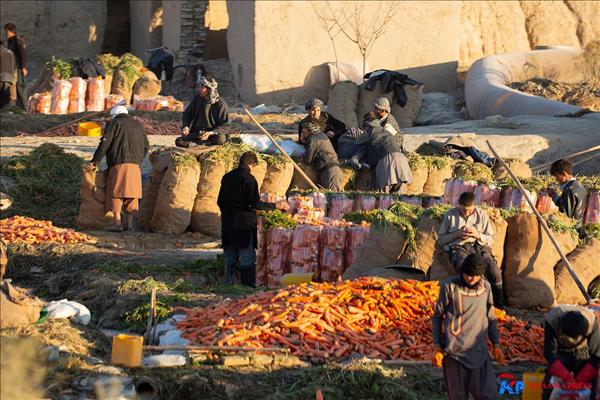
Afghanistan- Absence of domestic market will cost a financial battle for Afghan farmers
(MENAFN- Khaama Press) While agitations over hike in commodity prices due to the outbreak of the COVID-19 increase across the globe, meanwhile farmers in Afghanistan face off a different foe (e.g. deflation). during the initial days of the spread of the pandemic in Afghanistan however, inflation ramped up, which doubled both customers' and brands' vulnerabilities in terms of customer loss and price hike. On the contrary farmers and vendors of fresh fruits are currently suffering the absence of local markets for their agricultural products (i.e. watermelon).
Likewise the last year, farmers in Farah province again face the same scenario and bear the losses of customer size due to the lack of market availability. A report published by Tolonews reveals that farmers in Farah province are compelled to sell 1kg of watermelon at a drastically low price of Afn1, equivalent to ($0.013). weary of such huge losses, farmers in that province then decided to transport their products to the neighboring Herat province, where 1kg of watermelon was sold at a comparatively higher price of Afs4. However, in the capital Kabul, the farmers could sell 1kg of watermelon at a price of Afs10 ($0.13) somewhat higher than that of Herat. Nonetheless, the transportation cost of watermelon when supplied to Kabul from Farah costs extra overheads for the farmers, which has left the farmers in a double loss.
However, the local and central government have made several promises regarding the external market availability for watermelon, still there has been no promising action taken by the concerned bodies. Farmers are, therefore, forced to either dump the watermelon that remain as surplus or sell them at a drastically lower price which is an all-sided loss for the farmers. The initial cost associated to the production of watermelon that includes the use of excessive water and financial sources is disproportionately higher than the outcome/yield the farmers gain. On the other hand, officials from the relevant department claims that, helping farmers to find markets for their agricultural products is a vital part of their fundamental plans. Nevertheless, farmers slam the concerned authorities for having been failed to help them find access to market. Which is why each farmer has suffered a loss of Afs500,000 to Afs1 million. This is mainly because the government has failed to provide both financial and market availability support to the farmers. Moreover, the proprietors in Heart claim all the routs to neighboring Pakistan are closed. Since Pakistan is an external profit-making market for Afghan watermelon, therefore, vendors try to export their agricultural products to Pakistan as part of their efforts to determine an external market, especially for watermelon.
In addition, due to the low market size, other provinces of Afghanistan (i.e. Kunduz) too suffers the same issue. watermelon In Kunduz yield quite a lesser outturn when sold to the wholesalers and retailers. Kunduz has significance when it comes to the production of watermelon, but the farmers in Kunduz every year suffer financial losses, due to the absence of domestically low market size. Farmers claim that, they produce watermelon in abundance which absorbs a huge cost and water. but in case of non-availability of local market, the watermelon are sold at an extremely low market price, and the unsold products are kept as surplus or stocked in obsolete warehouses for the next season. Also many farmers are concerned about the dumped watermelon that is wasted because there are no proper storage facilities and most importantly, the financial resources as a backup for the farmers to compensate for the repercussion they will thus face.
Apart from that, last year's drought-affected around 26,200 families in Bamyan and around 128 families in Daikundi. This was more than a catastrophe for the farmers, as a result, they suffered huge losses in terms of low production due to the non-availability of enough water. Unlike other parts of Afghanistan that are well-off with groundwater, Bamyan is situated in the midst of the mountain chain. Which is why the province is more prone to droughts and water scarcity. Water scarcity in Bamyan results in the farmers be more vulnerable to double-sided losses - one being a shortage of water and another low market size.
For countries, that are susceptible to water scarcity, the achievement of water security will be profitable by way of importing water-intensive products instead of producing water-consuming products locally. but in the case of Afghanistan farmers could make a profit from the abundance of water resources by producing water-contained products such as melon and watermelon, and other water-contained products for export outside the country - instead of selling those to the wholesalers and retailers in the domestic markets.
DISCLAIMER – The opinions expressed in this publication are those of the authors. They do not purport to reflect the opinions or views of The Khaama Press News Agency . We welcome opinions and submissions to Khaama Press Opinions– Please email them to .

Legal Disclaimer:
MENAFN provides the
information “as is” without warranty of any kind. We do not accept
any responsibility or liability for the accuracy, content, images,
videos, licenses, completeness, legality, or reliability of the information
contained in this article. If you have any complaints or copyright
issues related to this article, kindly contact the provider above.


















Comments
No comment